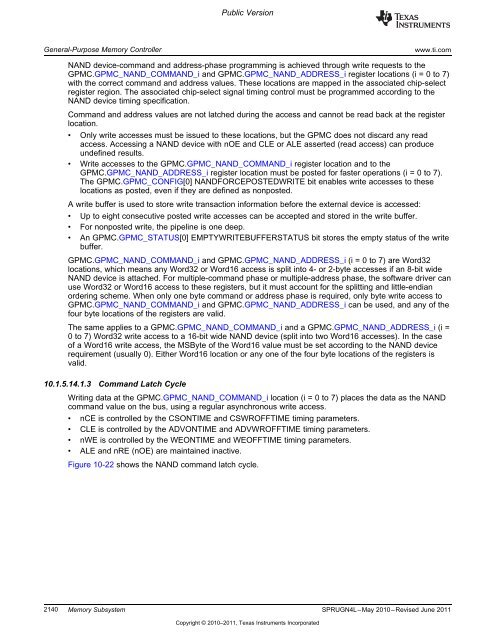Chapter 10 Memory Subsystem.pdf
Chapter 10 Memory Subsystem.pdf
Chapter 10 Memory Subsystem.pdf
Create successful ePaper yourself
Turn your PDF publications into a flip-book with our unique Google optimized e-Paper software.
Public Version<br />
General-Purpose <strong>Memory</strong> Controller www.ti.com<br />
NAND device-command and address-phase programming is achieved through write requests to the<br />
GPMC.GPMC_NAND_COMMAND_i and GPMC.GPMC_NAND_ADDRESS_i register locations (i = 0 to 7)<br />
with the correct command and address values. These locations are mapped in the associated chip-select<br />
register region. The associated chip-select signal timing control must be programmed according to the<br />
NAND device timing specification.<br />
Command and address values are not latched during the access and cannot be read back at the register<br />
location.<br />
• Only write accesses must be issued to these locations, but the GPMC does not discard any read<br />
access. Accessing a NAND device with nOE and CLE or ALE asserted (read access) can produce<br />
undefined results.<br />
• Write accesses to the GPMC.GPMC_NAND_COMMAND_i register location and to the<br />
GPMC.GPMC_NAND_ADDRESS_i register location must be posted for faster operations (i = 0 to 7).<br />
The GPMC.GPMC_CONFIG[0] NANDFORCEPOSTEDWRITE bit enables write accesses to these<br />
locations as posted, even if they are defined as nonposted.<br />
A write buffer is used to store write transaction information before the external device is accessed:<br />
• Up to eight consecutive posted write accesses can be accepted and stored in the write buffer.<br />
• For nonposted write, the pipeline is one deep.<br />
• An GPMC.GPMC_STATUS[0] EMPTYWRITEBUFFERSTATUS bit stores the empty status of the write<br />
buffer.<br />
GPMC.GPMC_NAND_COMMAND_i and GPMC.GPMC_NAND_ADDRESS_i (i = 0 to 7) are Word32<br />
locations, which means any Word32 or Word16 access is split into 4- or 2-byte accesses if an 8-bit wide<br />
NAND device is attached. For multiple-command phase or multiple-address phase, the software driver can<br />
use Word32 or Word16 access to these registers, but it must account for the splitting and little-endian<br />
ordering scheme. When only one byte command or address phase is required, only byte write access to<br />
GPMC.GPMC_NAND_COMMAND_i and GPMC.GPMC_NAND_ADDRESS_i can be used, and any of the<br />
four byte locations of the registers are valid.<br />
The same applies to a GPMC.GPMC_NAND_COMMAND_i and a GPMC.GPMC_NAND_ADDRESS_i (i =<br />
0 to 7) Word32 write access to a 16-bit wide NAND device (split into two Word16 accesses). In the case<br />
of a Word16 write access, the MSByte of the Word16 value must be set according to the NAND device<br />
requirement (usually 0). Either Word16 location or any one of the four byte locations of the registers is<br />
valid.<br />
<strong>10</strong>.1.5.14.1.3 Command Latch Cycle<br />
Writing data at the GPMC.GPMC_NAND_COMMAND_i location (i = 0 to 7) places the data as the NAND<br />
command value on the bus, using a regular asynchronous write access.<br />
• nCE is controlled by the CSONTIME and CSWROFFTIME timing parameters.<br />
• CLE is controlled by the ADVONTIME and ADVWROFFTIME timing parameters.<br />
• nWE is controlled by the WEONTIME and WEOFFTIME timing parameters.<br />
• ALE and nRE (nOE) are maintained inactive.<br />
Figure <strong>10</strong>-22 shows the NAND command latch cycle.<br />
2140 <strong>Memory</strong> <strong>Subsystem</strong> SPRUGN4L–May 20<strong>10</strong>–Revised June 2011<br />
Copyright © 20<strong>10</strong>–2011, Texas Instruments Incorporated

















